
Brian Lara International Cricket 2007
Written by: Rik
Date posted: February 18, 2015
- Genre: Sport
- Developed by: Codemasters
- Published by: Codemasters
- Year released: 2007
- Our score: 6
Brian Lara International Cricket 2005 wasn’t perfect but, in deviating from the well-trodden and frankly depressing path taken by most cricket games, it stood out as a beacon of hope and optimism for the long-suffering cricket game fan. Such was my own enthusiasm, upon hearing that Codemasters were planning a follow-up, I broke the habit of a lifetime and started lurking in the game’s official forums, desperate for any tidbits of information about the forthcoming update. Of course, the main thing that I and most of my fellow forum-lurkers really wanted to know was whether they’d fix some, if not all, of the fairly significant problems that (for all its good qualities) undermined enjoyment in BLIC 2005. Because if they did, then we really would have a game on our hands – a decent cricket game, at last.
As the release date for Brian Lara International Cricket 2007 approached, feedback from gameplay videos and demos wasn’t promising, although they came with all of the usual assurances that things would be fixed in the final version. Cricket veterans usually know within the first half-hour whether a game is going to be any good, and as those who bought the game on release day started sharing their initial impressions, it soon became apparent that BLIC 2007 wasn’t going to be the game we were all hoping for. In a rare display of rationality and common sense in this particular area, I followed my head rather than my heart and didn’t buy a copy.
At least in 2007, I didn’t. In 2014, motivated by a combination of factors including a low, low price and guilt at having slagged it off in passing on FFG without really playing it – a recurring error of mine – I decided to give it a go. At the end of my first match, on the second-highest difficulty setting (‘County’, which I’d used in BLIC 2005), and with only a rudimentary understanding of the control scheme based on rather dusty memories, I secured a massive victory, having scored over 400 in 50 overs before bowling the opposition out for less than 70. Admittedly, paying £1 rather than £30 does mitigate the sense of hollow disappointment somewhat, but it can’t eradicate it completely.
In a way, I suppose, I was pleased, seeing as this early experience backed up my published claim, made from a position of ignorance, that not only did the 2007 version not improve on the 2005 effort, it was actually a worse game overall. I’ve deleted that from the old review now, seeing as I’m admitting to it here, but that slight error of judgement aside, it’s worth revisiting that piece, if only because the two games are so similar that most description of the fundamental elements does not need to be repeated here. Indeed, while 2005 developers Swordfish weren’t involved this time, they almost deserve a mention on the credits, seeing as their work forms the basis of this update.
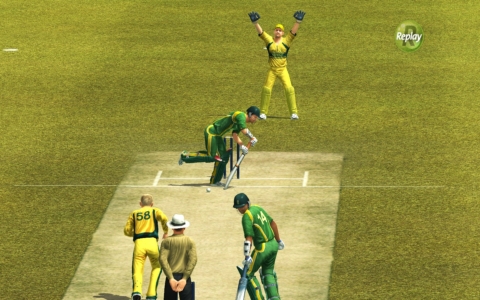
You can still get deceived by the AI use of the ‘surprise delivery’ when high on confidence. It’s a shame the computer doesn’t have any other tricks up its sleeve.
In my review (or, rather, the accompanying side-piece), I identified ten major cricket-based problems with BLIC 2005. I don’t think it’s uncharitable to say that eight of those remain in the newer version. So, while the AI may be better at running between the wickets, and you’re less likely to be hit for six over third man, edges remain unconvincing, defensive shots are too solid, there’s no way to select front or back foot play, shots still go pretty much where you were aiming, the AI continues to make odd decisions, there’s a massive and almost comical amount of variation in bowling speeds, the AI batsmen get bowled a lot, and the fielding is still a bit crap.
In fact, the fielding is worse this time, because the fielding meter, previously used for outfield business only, has been extended to ‘keeper and slip catches, making wicket taking altogether more difficult. By switching control from bowler to slip fielder in an instant, BLIC 2007 is asking more of you than a real-life cricketer, demanding that you not only focus on delivering a good ball, but also the potential catch coming from the edge moments later. To compensate for the cat-like reflexes required for such a feat, the game has edged chances loop unconvincingly into the air, in theory allowing you some opportunity to grope helplessly for the button that effects the catch. Needless to say, opportunities go down all over the place, but it matters not, given the general inadequacy of the computer opposition (I dropped, by a rough count, eight on my way to dismissing India in my first match, referenced above). Ground fielding has been improved slightly, in that you can throw to the bowler’s end now, although there remains among the game’s fielders a pathological obsession with throwing the stumps down, regardless of the game situation, and whether or not the batsmen are taking a run. Even Super International Cricket allowed you to field the ball calmly when close to the wicket.
When it comes to identifying areas in which BLIC 2007 improves over its predecessor, it gets a bit tricky. Aside from the couple of fixes we’ve already mentioned, there are the graphics, which are a bit more detailed and realistic looking – and while the animations have been retained wholesale from the previous version, the cartoony appearance of the players has been abandoned. You wouldn’t exactly say the players were recognisable (and, again, as in 2005, it’s only real players in officially sanctioned ICC events, in this case the 2006 Champions Trophy and the 2007 World Cup) but they do look a bit better this time around, and there’s more detail on the pitch and in the background too.
Batting has also been improved; if you have an analogue joypad then you have greater control over shot placement, while the sweep shot has been added (and given a button all of its own, which means you can play a reverse sweep, and play sweeps all around the wicket – even straight, which makes no sense, and won’t work, but you can still do it), along with the option to advance down the wicket when your confidence meter is at the top, allowing you to get to the pitch of the ball and stroke along the ground, or whack it over the top in the air. It all works very well, and gives you more options when batting, with the only downside being that the hopeless AI bowling and captaincy can’t cope with fairly limited and conventional strokeplay, and so with these new options at your disposal, you can smack it to all parts.
Cricket fans will be familiar with the term buffet bowling (it even gets a mention in the commentary – which, as before, has little to do with the onfield action and is often just a case of two men talking about cricket in general) – put simply, it means the batsmen help themselves (to runs, and as many of them as they like) and that describes the kind of bowling on offer here. The ball is repeatedly pitched full for you to drive for four, and even if you eschew the expanded batting options and choose the hardest difficulty setting, you should have no problem scoring at a fair old rate. In fact, my most common form of dismissal was advancing down the wicket, missing the ball and accidentally hitting the run button rather than the one to return to the crease, so a conservative approach is probably best for really huge scores, although it’s not as much fun (or really necessary, given the standard of opposition batting).
Tail end batsmen were a bit too good in 2005, and that’s been rectified here. You also have batsmen low on confidence assuming the tailender’s set of incompetent animations, and while you can kind of understand the logic behind it, it really looks a bit daft when you have an opening batsman poking at the ball like Phil Tufnell. Especially when he could be on 150 at the time, which is possible, given how quickly confidence is gained and lost. There are brief periods of pressure, which hint at what might have been, but then you get served up an easy one to hit, and it’s all tickety-boo again.
AI batters are slightly more capable than before, especially left handers, who seem capable of driving almost anything through cover for four, but they’re prone to collapses and will never bat out their overs if you play a full 50 over match, even if you surrender control and opt to skip the innings (a welcome addition, and an essential feature for all cricket games). As before, you can clean up the tail with a succession of full straight deliveries, and while taking a hatful of wickets either bowled or lbw is undeniably satisfying, it all comes too cheaply. Bowling is still more fun than in most cricket games, and when the individual bowlers in your attack have actions that match their real-life counterparts, for example the open-chested pace of Ntini and the upright accuracy of Pollock opening the bowling for South Africa, then you can really get into it.
But this was the case in 2005 too, and you get the sense that most of what’s good here was there already in the previous version, with the graphics given a polish, a few other areas tweaked, and then rush-released in time for the World Cup (the Caribbean themed presentation – the 2007 World Cup was in the West Indies – makes the intended timing of the release clear). If it was rushed, then there are some hints here in the form of general sloppiness – right handed batsmen taking guard as a left hander, and vice versa, bowlers remarking their run even when there hasn’t been a bowling change, and commentators using the wrong name. Most irritating of all are the extremely loud calls of the batsmen when running (a feature I could easily do without altogether) – they frequently shout “THAT’S GONE” (ie, to the boundary, so let’s stop running, old boy) when it clearly hasn’t, and is going to be fielded.
Despite its flaws, BLIC 2007 is better than most, and can provide a few days’ fun. It’s pretty hard to say whether it’s better or worse than BLIC 2005, but what’s disappointing is that nothing has been done to build upon the significant potential of the previous game, potential that will forever be left unrealised, given that this was the final entry in the series. Not as bad as most cricket games, then, but absolutely nowhere near as good as it could have been.

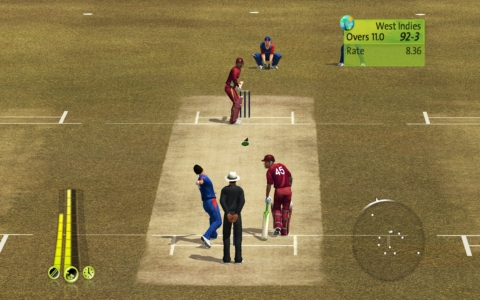
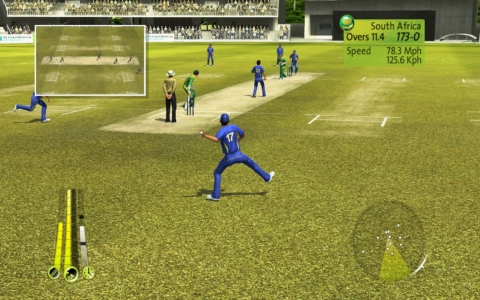
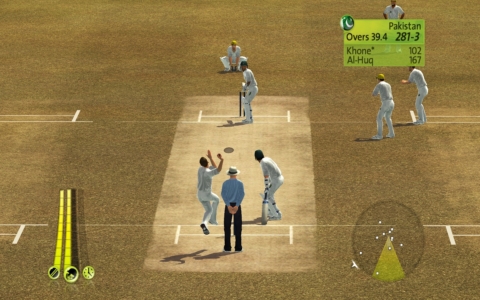
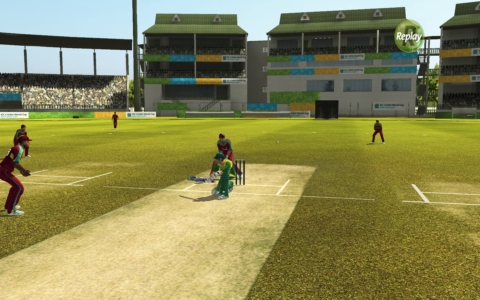
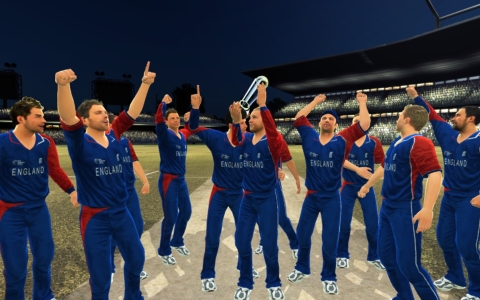

 Posts
Posts
Glad to see this one get covered; I’ve played both it and ’05, and while this one isn’t terrible, it doesn’t really feel like anything was really improved in the two years in between. And for the record, I’m glad somebody else was irritated by the extremely loud calls between the batsmen (IF YOU WANT!) and had a giggle at a low-confidence Ponting or Tendulkar ham-fistedly swiping at balls with all the grace and precision of…well, me.
I’m also starting to become entirely convinced that the Cricket Captain series might be the most fulfilling cricket experience out there despite the lack of actual involvement…
February 19, 2015 @ 5:50 am
I noticed that they re-used some assets from this in Ashes Cricket 2009 (and, I believe, International Cricket 2010, although I haven’t played that one) which I bought in the hope that maybe it would be a better version of the BLIC games, but sadly the gameplay reverted to EA Cricket-style depressing stodge.
One thing I liked in Cricket Captain that doesn’t seem to have been implemented in other games is the various strengths/weaknesses of batsmen – such as a preference for off or leg side play. It’d be good to have plans to different batters – especially with a view to getting them out early (e.g. pitch it full to Shane Watson and get him lbw). But I guess they’d have to get a few more of the basics right before such a thing would work.
Haven’t played Don Bradman ’14, maybe it’s worth a go…
February 19, 2015 @ 2:42 pm
From what I gather, Bradman ’14 addresses two of your chief concerns about most cricket games (bowling consistently at line and length being way too easy and seeing where the ball will pitch long before the actual delivery while batting), and I’m intrigued by the Career Mode, so I’m interested to see if it’s as good as it appears.
If you do give it a shot, I’d like to know what you think of it…
February 20, 2015 @ 8:16 am